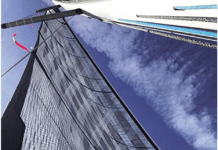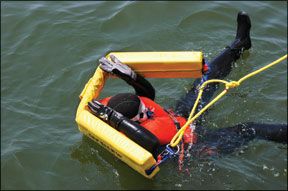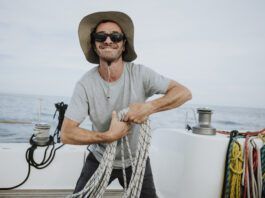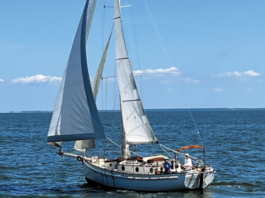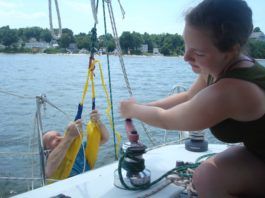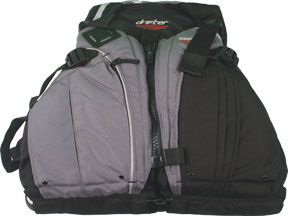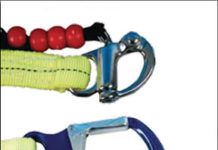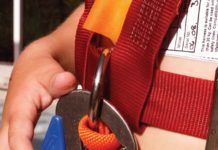West Marine Updates Recalled Tether
West Marine has released a new, improved version of the safety tethers it voluntarily recalled last summer. As we reported in the August 2010 issue, West Marine recalled its model 9553512 (single) and 9553504 (double) safety tethers—which featured Kong hooks on the boat end and snap shackles on the user end—over concerns about the durability of the split ring connecting the snap shackle’s release pin and the lanyard.
Safety Tips From the Pros
Every two years, some 150 offshore sailboats line up in Newport, RI, to race roughly 650 miles to Bermuda, a semi-tropical island in the western Atlantic, almost due east of Charleston, SC. While this is a relatively short ocean passage, it is not always an easy one. Boats have met serious gale conditions and dodged hurricanes during past editions of this race.
Life Raft Stowage: The Overlooked Necessity
Sometimes, it seems that safety is a dirty word in the boat-building industry. A favorite marketing catchword is “blue water cruiser.” We assume this means a boat capable of going to sea, rather than a boat designed to tiptoe along the shore.
Salus PFD Fits Infants Less Than 20 Pounds
In October 2006, Practical Sailor tested infants life jackets and our top pick was MTI Adventurewears Bay Bee 201-I, one of the few jackets we looked at that met our chief criteria for an infant life vest: flotation that turned the infant face up and kept his head well above water, comfortable snug fit, easy donning, and a wide grab strap near the top that allowed someone to easily lift the child from the water or dinghy.
Seascoopa Man-Overboard Recovery Gear Tested Against Lifesling2
Practical Sailor tests the Seascoopa man-overboard device and compares it to our top pick in the previous man-overboard device test, the horseshoe buoy Lifesling2. Seascoopa solves many of the problems of other parbuckle-type devices in that it is compact, lightweight and has an interlocking three-piece carbon-fiber whisker pole that holds the trapezoid-shaped net out at right angles to the boat. The ultimate goal of the device is to make it possible for a single person to safely secure and lift a much heavier person aboard with minimal effort. In addition to reducing the risks associated with a vertical lift, the Seascoopa aims to simplify making contact with the victim. Because it can be employed while the vessel is slowly making way, the recovery involves less stationary bobbing, when the boat is at the mercy of wind and waves.
Shedding Light on Safety
A recent ocean race-aboard a Cape Dory 25 sans lifelines in 30- to 40-knot winds and 5- to 10-foot seas-presented a good opportunity to sea-trial Wichards LyfSafe jackline kit. Wichard Inc., which is based in France and has an office in Vermont, has been making marine hardware and accessories for more than 30 years. Its LyfSafe kit offers a ready-to-go jackline setup and comes with everything needed to install the system.
Mailport: April 2010
Letters to Practical Sailor's April 2010 issue include: MOB drills, tethers, nav lights, cleats, no-buff shines and tankless water heaters.
Mens Foul-Weather Gear Update
Practical Sailor recently tested the first line of foul-weather gear released by Massachusetts-based Bluestorm. The three mens bibs-and-jacket sets are named appropriately for the general areas they are designed for use in: the lightweight Latitude 33, medium-weight Latitude 48, and heavy-duty Latitude 61. The sailing jackets and bibs were tested for wind- and water-resistance, fit and comfort, design, construction quality, warmth, design and fit of hood, design and construction of zippers, and reflectivity. Small, innovative details that Bluestorm incorporated into its foulies include the triple-closure system for jacket storm flaps and recessed Velcro fasteners. All sets have excellent hood design, and testers found the jackets to be supple, highly breathable, and comfortable, if a bit pricey.
Practical Sailor Tests Lightweight Tether Aimed at Racing Sailors
Theres a reason why we recommend safety tethers-the umbilical cords that connect the jacklines on our boats to the harnesses on our bodies-be 6 feet long or shorter. Getting dragged behind a boat, even at the sedate speed of 4 knots, can easily drown a person. Unless someone is on hand to haul you on board, survival relies on a superhuman burst of adrenaline. Though rare, there have been some highly publicized deaths involving harnesses. The story of Harvey Shalsky, a sailor in the 1999 Double-handed Farallones Race, is familiar to most racers. Shalsky, racing with longtime partner Mark Van Selst, drowned while tethered to his J/29 White Lightning. Van Selst was unable to slow the boat or haul his partner in, and eventually cut loose Shalsky (who was by then unconscious) so that following boats could recover him. The hazards associated with a tether that cannot be easily released under load prompted the International Sailing Federation (ISAF, the council responsible for regulating offshore sailing races) to recommend this feature in tether designs. It is not a requirement, only a recommendation, and ISAF does not stipulate what method should be used for the release.
Practical Sailor Tests a Ruggedly Built Safety Harness and Tether for Kids
Never mind what your experience tells you. Children do not go to sea. At least that is the only logical conclusion we can reach as we deal with the lack of adequate offshore safety equipment for kids. In October 2006, we ran down more than a dozen life jackets for infants and toddlers. There were only a few worth writing about, and none met our full expectations. Of the lot, we pegged the MTI Adventurewear Bay Bee 201-1, the Mustang Survival MV-3150 and MV-3155, and the Sospenders 12ACH as standouts, and all of these products are still available today. In the December 2006 and January 2007 issues, we dug into the topic of safety harnesses and tethers, and the outcome was worse. One product in that test, a safety tether designed for children more than 50 pounds, snapped under the load of a 35-pound weight being dropped from six feet. The tether, from Jim Buoy, underwent an upgrade immediately after our report.













